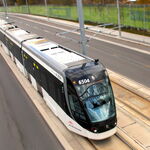They are not planning a 2:1 swap for CLRVs to ALRVs though.
The best table to look at is the somewhat dated table Steve Munro put together in June 2013 -
https://swanboatsteve.files.wordpress.com/2013/06/lvlrvcap201306.pdf as part of his article
https://swanboatsteve.wordpress.com/2013/06/25/ttc-low-floor-lrv-roll-out-plan-released
The numbers have changed a bit since then, but not significantly. For AM peak, Queen gets will get 119% of the current capacity. But it's the smallest. King is 132% (though some of this was already rolled out during the 2014 service increase for 504 that anticipated that the new Flexities would release enough CLRVs). But the real winners are 156% on 505, 170% on 511.
This is because the 11 (then) current CLRVs were to be replaced by 10 Flexities on Bathurst. And the 19 CLRVs on Dundas would be replaced by 14 Flexities. If you look at the January 2015 Fleet Plan in
https://swanboatsteve.wordpress.com/2015/01/28/ttc-2015-fleet-plans/ these are still the same numbers (though 505 is now expected to increase to 17 Flexities by 2019!)
There is no where near a 2:1 replacement ratio!





